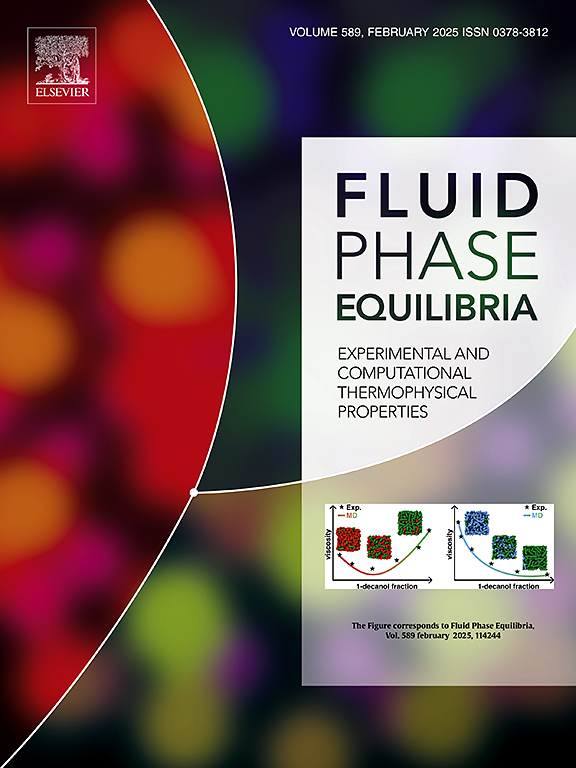Hydrophobic interactions described using hetero-segmented PC-SAFT: 2. Surfactants and their aqueous solutions
IF 2.8
3区 工程技术
Q3 CHEMISTRY, PHYSICAL
引用次数: 0
Abstract
Despite their importance for industry and pharmaceuticals applications, description of aqueous solutions that contain surfactants is still a challenging task in thermodynamic modeling. As a first step towards a holistic modeling approach, which is also applicable for concentrated surfactant solutions, this work aimed to model the intrinsic behavior of surfactant molecules. For this purpose, we applied hetero-segmented PC-SAFT as a group contribution method to build surfactant molecules from different groups, which separately characterize the hydrophobic tail and the hydrophilic head of the surfactant. While the hydrophobic tail is modeled by the parameterization developed in the first part of this paper series (M. Rother, G. Sadowski, Fluid Phase Equilibria 582 (2024)), this work focuses on extending the parameter matrix to model the hydrophilic head. We considered the surfactant classes CiG1, CiEj and MEGA-i. The parameters for the surfactant head groups were adjusted to sorption data of surfactant/alcohol systems and to partition coefficients of the surfactants in n-alkane/water systems and n-alcohol/water systems. As a benchmark of the new parameterization, we modeled the critical micelle concentration as a function of temperature for these three surfactant classes using a newly developed, explicit equation for calculating this quantity. The results are in even quantitative agreement with the experimental data.

用异段PC-SAFT描述疏水相互作用:表面活性剂及其水溶液
尽管它们在工业和制药应用中很重要,但在热力学建模中,描述含有表面活性剂的水溶液仍然是一项具有挑战性的任务。作为整体建模方法的第一步,该方法也适用于浓缩表面活性剂溶液,本工作旨在模拟表面活性剂分子的内在行为。为此,我们采用异段PC-SAFT作为基团贡献方法,从不同基团构建表面活性剂分子,分别表征表面活性剂的疏水尾部和亲水头部。虽然疏水尾部是通过本系列论文第一部分(M. Rother, G. Sadowski, Fluid Phase Equilibria 582(2024))中开发的参数化模型来建模的,但这项工作的重点是扩展参数矩阵来模拟亲水头部。我们考虑了表面活性剂CiG1、CiEj和MEGA-i。根据表面活性剂/醇体系的吸附数据和表面活性剂在正构烷烃/水体系和正醇/水体系中的分配系数,调整了表面活性剂头基团的参数。作为新参数化的基准,我们使用一个新开发的显式方程来计算这三种表面活性剂的临界胶束浓度作为温度的函数。结果与实验数据在定量上基本一致。
本文章由计算机程序翻译,如有差异,请以英文原文为准。
求助全文
约1分钟内获得全文
求助全文
来源期刊

Fluid Phase Equilibria
工程技术-工程:化工
CiteScore
5.30
自引率
15.40%
发文量
223
审稿时长
53 days
期刊介绍:
Fluid Phase Equilibria publishes high-quality papers dealing with experimental, theoretical, and applied research related to equilibrium and transport properties of fluids, solids, and interfaces. Subjects of interest include physical/phase and chemical equilibria; equilibrium and nonequilibrium thermophysical properties; fundamental thermodynamic relations; and stability. The systems central to the journal include pure substances and mixtures of organic and inorganic materials, including polymers, biochemicals, and surfactants with sufficient characterization of composition and purity for the results to be reproduced. Alloys are of interest only when thermodynamic studies are included, purely material studies will not be considered. In all cases, authors are expected to provide physical or chemical interpretations of the results.
Experimental research can include measurements under all conditions of temperature, pressure, and composition, including critical and supercritical. Measurements are to be associated with systems and conditions of fundamental or applied interest, and may not be only a collection of routine data, such as physical property or solubility measurements at limited pressures and temperatures close to ambient, or surfactant studies focussed strictly on micellisation or micelle structure. Papers reporting common data must be accompanied by new physical insights and/or contemporary or new theory or techniques.
 求助内容:
求助内容: 应助结果提醒方式:
应助结果提醒方式:


